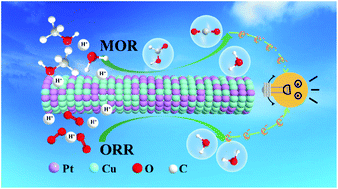Insights into the morphology and composition effects of one-dimensional CuPt nanostructures on the electrocatalytic activities and methanol oxidation mechanism by in situ FTIR†
Abstract
Morphology modulation and surface structure-controlled synthesis are two effective ways to tune the electrocatalytic activities of metal nanomaterials. Pt-based binary or ternary metal nanostructures have become a class of promising catalysts toward the oxygen reduction reaction (ORR) and the methanol oxidation reaction (MOR) for direct methanol fuel cells. Herein to reveal the morphology and surface structure effects of one-dimensional (1D) Pt-based nanostructures on their electrocatalytic properties, two types of 1D CuPt nanowires (CuPt NWs) and CuPt nanotubes (CuPt NTs) with tunable surface structures and compositions were fabricated using a convenient and easy strategy. It was found that among all the studied samples, CuPt2.22 NWs exhibited the highest efficiency catalytic performances for both the ORR and MOR in an acidic electrolyte. For the ORR, CuPt2.22 NWs exhibited an onset potential (Eonset) of 0.749 V and a half-wave potential (E1/2) of 0.577 V, which are more positive than those of the commercial Pt/C (0.668 V and 0.558 V). On the other hand, CuPt2.22 NWs show a specific activity of 20.76 mA cm−2 and a mass activity of 0.171 mA μgPt−1 for the MOR, which are 7.75 and 1.82 times, respectively, larger than those of Pt/C (2.679 mA cm−2 and 0.094 mA μgPt−1). Meanwhile, the reaction mechanism of the MOR on CuPt2.22 NWs was examined by in situ FTIR. From the enhanced IR absorption, the linear- and bridge-adsorbed CO intermediates can be determined during the methanol oxidation on CuPt2.22 NWs, from which the MOR proceeds through a dual reaction pathway. This work reveals that rationally tuning the electronic structures of 1D metal nanomaterials by well-controlling the composition and surface morphology on the nanoscale could greatly enhance the catalytic properties, which are very important for their application in fuel cells.



 Please wait while we load your content...
Please wait while we load your content...